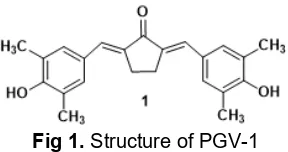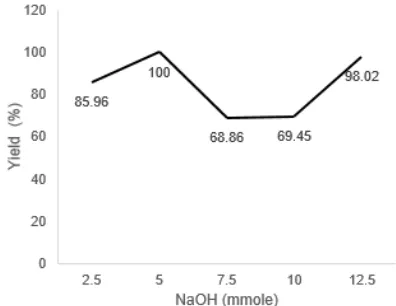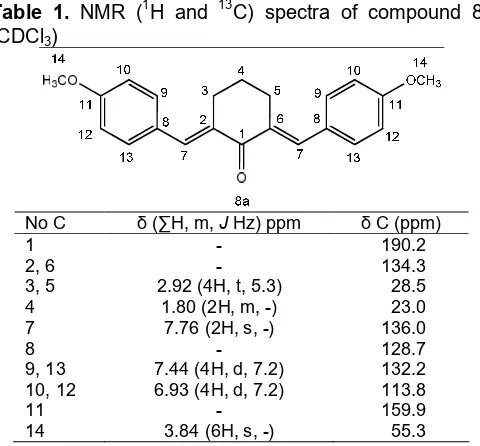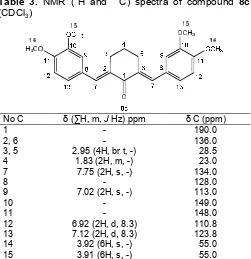Microwave-Assisted Organic Reactions: Eco-friendly Synthesis
of Dibenzylidenecyclohexanone Derivatives via Crossed Aldol Condensation
Sri Handayani
1,*, Cornelia Budimarwanti
1, and Winarto Haryadi
2 1Chemistry Education Department, Faculty of Mathematics and Natural Sciences, Yogyakarta State University, Kampus Karangmalang, Yogyakarta 55281, Indonesia
2
Department of Chemistry, Faculty of Mathematics and Natural Sciences, Universitas Gadjah Mada, Sekip Utara, Yogyakarta 55281, Indonesia
Received May 30, 2017; Accepted July 17, 2017
ABSTRACT
The synthesis of dibenzylidenecyclohexanone derivatives via environmentally friendly Microwave Assisted Organic Synthesis (MAOS) crossed aldol condensation had been carried out. The condensation reaction to synthesize the dibenzylidenecyclohexanone 8b was performed by reacting benzaldehyde 4 and cyclohexanone 2 (mole ratio of 2:1) with NaOH as catalyst for 2 min under microwave irradiation. The benzaldehyde derivatives used in this study were 4-methoxybenzaldehyde and 3,4-dimethoxybenzaldehyde and gave of (2E,6E)-bis(4-methoxy benzylidene)cyclohexanone 8a and (2E,6E)-bis(3,4-dimethoxybenzylidene)cyclohexanone 8c, respectively. The study was commenced by searching the optimum concentration of NaOH. The reaction yield was determined by TLC scanner and the structure was elucidated by FTIR and NMR spectrometers. For the comparison, the reaction was also carried out by using stirring method. The results showed that optimum concentration of NaOH was 5 mmole. By using the optimum condition via MAOS method, the compounds8a,8b and8cwere obtained in 100, 98 and 93%, respectively. The research also proved that the method of dibenzylidenecyclohexanones (8) synthesis using MAOS was more efficient than stirring method.
Keywords:dibenzylidenecyclohexanone; MAOS; eco-friendly
ABSTRAK
Telah dilakukan sintesis dibenzilidensikloheksanon dan turunannya melalui reaksi kondensasi aldol silang yang ramah lingkungan menggunakan metode MAOS. Sintesis dibenzilidensikloheksanon (8b) dilakukan melalui reaksi kondensasi antara benzaldehida 4 dan sikloheksanon2 dalam krus porselen dengan rasio mol 2:1 menggunakan katalis natrium hidroksida selama 2 menit di dalam microwave. Turunan benzaldehida yang digunakan adalah 4-metoksibenzaldehida dan 3,4-di4-metoksibenzaldehida untuk mensintesis (2E,6E)-bis(4-metoksibenziliden) siklo heksanon (8a) dan (2E,6E)-bis(3,4-dimetoksibenziliden)sikloheksanon (8c). Studi dimulai dengan optimasi konsentrasi NaOH sebagai katalis. Rendemen produk ditentukan menggunakan TLC dan TLC scanner dan elusidasi struktur dilakukan menggunakan spectrometer FTIR dan NMR. Sebagai pembanding, dilakukan sintesis senyawa yang sama dengan menggunakan metode pengadukan. Konsentrasi NaOH optimum diperoleh pada 5 mmol. Rendemen hasil sintesis senyawa8a,8b, dan8cberturut-turut sebesar 100, 98 dan 93%. Hasil riset membuktikan bahwa metode sintesis dibenzilidensikloheksanon menggunakan MAOS lebih efisien daripada metode pengadukan.
Kata Kunci:dibenzilidensikloheksanon; MAOS; ramah lingkungan
INTRODUCTION
Benzalacetone has a very interesting structure for being studied and developed. Several benzalacetone analogues have been reported as an active antioxidant [1-4], antimutagenic [5], and anti-tubercular agent [6]. One of dibenzalacetone derivatives is 2,5-bis(4'-hydroxy-3',5'-dimethyl)-benzylidenecyclopenthanone 1 or is commonly known as the PGV-1 (Fig. 1) was reported for
having potential inhibition to the growth of tumors in T47D cells [7]. This compound can be prepared from cyclopentanone and aldehyde via crossed aldol condensation. In this study, we would like to synthesize PGV-1 analogue derived from cyclohexanone and benzaldehyde. Due to the similarity of chemical structure, it was expected that the condensation products displayed similar biological activities.
Some researchers have been developed crossed
Fig 1.Structure of PGV-1
aldol condensation reaction with various methods and catalysts. Several methods have been reported, such as, under stirring [2], solvent free reaction [8], and ultrasonic-assisted [9] methods. In addition, heterogeneous catalysts has been used for crossed aldol condensation reaction including hydrotalcite [10-11], ZrO2-montmorillonit [12] and NaOH/ZrO2 -montmorillonite as cooperative catalyst [13]. While the homogenous catalysts that commonly used for aldol condensation were NaOH [2] and H2SO4[14].
Synthesis of vanillinacetone (a benzalacetone derivatives)viacrossed aldol condensation under stirring for 3 h yielded the product in 13-94% yields [15]. Solvent-free synthesis of dibenzalacetone’s derivatives
via crossed aldol condensation reaction conducted by Salehi et al. [16] resulted in 82-98% yield with reaction time of 2-8 h. While the synthesis of dibenzalacetone derivatives via ultrasonic-assisted-method with a reaction time of about 1.5 h gave the products in 70-97% yield [9].
Nowadays, trend of synthetic process has been shifting from traditional concept that focused on optimum yield into eco-friendly processes that giving more attention to reaction processes. Eco-friendly reaction process is a reaction which eliminates or reduces waste, saves energy and avoids the use of toxic or hazardous compounds [17]. Based on these criteria, several researchers have conducted the synthesis of organic compounds using the Microwave Assisted Organic Synthesis (MAOS) method [4,9-10]. The advantageous of the synthesis via MAOS reaction are the faster, cleaner, more economic, and environmental friendly than stirring method. It can also use household microwave ovens and only requires simple glassware and more pedagogic [20]. MAOS is a new method which is expected to effectively reduce reaction time, energy and harmful solvents. In connection to our study, we would like to apply MAOS method in the synthesis of dibenzylidenecyclohexanones8.
EXPERIMENTAL SECTION
Materials
The materials used for the synthesis of dibenzylidenecyclohexanones 8 included benzaldehyde, 4-methoxybenzaldehyde, 3,4-dimethoxybenzaldehyde, cyclohexanone, sodium hydroxide, methanol, chloroform,
n-hexane and TLC plate of silica gel 60 F254. All the chemicals were purchased from E-Merck.
Instrumentation
Microwave that used for synthesis was SIGMATIC SMO-25SSG 900 W 2450 MHz. Analytical instruments that used for structure elucidation were Nicolet Avatar 360 FTIR for FTIR-spectra investigation and (1H and 13C) Nuclear magnetic resonance (NMR) 400 MHz Agilent together with HMQC. While, the yield determination and identification analysis were used TLC Scanner (Camag).
Procedure
Optimization of sodium hydroxide concentration on the synthesis of (2E,6E)-bis(4-methoxybenzylidene) cyclohexanone (8a)
Sodium hydroxide (2.5 mmol) in 2 mL methanol was placed in a porcelain crucible. 4-methoxy benzaldehyde (10 mmol) and cyclohexanone (5 mmol) were consecutively added. Porcelain crucible was covered using aluminum foil and heated in the microwave for 2 min. Reaction products were analyzed using TLC and TLC scanner to determine the yield. The same procedure was applied using different NaOH concentrations of 5, 7.5, 10 and 12.5 mmol. The yields were determined by the same method as previous research [13].
Synthesis of (2E,6E)-dibenzylidenecyclohexanone 8b by MAOS
Sodium hydroxide (5 mmol) was dissolved into 2 mL methanol in a porcelain crucible in which benzaldehyde (10 mmol) and cyclohexanone (5 mmol) were added. The porcelain crucible covered with aluminum foil and then heated in a microwave oven for 2 min. The product was dried and weighted to determine the yield of the reaction. The products were then analyzed using TLC, TLC scanner, and identified by FTIR and NMR spectrometers. The similar procedure was carried out to synthesizes the (2E,6E )-bis(4-methoxybenzylidene)cyclohexanone 8a and (2E, 6E)-bis(3,4-dimethoxybenzylidene)cyclohexanone8c.
Synthesis of (2E,6E)-dibenzylidenecyclohexanone 8b by stirring method
analysis using same method as for MAOS products. Further analysis was performed by similar with the results of the synthesis using MAOS methods. Structure elucidation had been conducted after the sample was recrystallized from methanol.
The FTIR (KBr) (cm-1) 8a: 2938 (C-H stretching), 1594 (C=O), 1554 (C=C alkene), 1504 and 1416 (C=C aromatic), 1451 (CH2 methylene), 1162-1112 (C-O), 843 (para substitution). FTIR (KBr) (cm-1), 8b: 2926 (C-H stretching), 1604 (C=O), 1573 and 1488 (C=C aromatic), 1552 (C=C alkene), 1443 (CH2 methylene). FTIR (KBr) (cm-1) 8c: 2930 (C-H stretching), 1596 (C=O), 1513 (C=C aromatic), 1451 (CH2 methylene), 1250-1139 (C-O), 847 (parasubstitution) [21].
RESULT AND DISCUSSION
Eco-friendly synthesis process is a chemical reaction using efficient raw material, less waste, free toxic chemicals and a short reaction time [23]. Based on these conditions, synthesis dibenzylidenecyclohexanone was done using MAOS method. This method has several advantages compared with conventional heating method. In the conventional method, the reaction container was heated, and the heat was then transfered into the reaction system by convection process. Thus, this process took long time and high energy. Heating with microwave was more efficient in terms of energy, homogen temperature and short time. Therefore, the main advantages of using the microwave were very short reaction time and high yield [24].
The study began with the optimization concentration of NaOH as catalyst. The results showed that MAOS-assisted-synthesis of dibenzylidenecyclo hexanone produced a dried yellow precipitate with neither residual solvents nor alkaline catalyst solution. Results of optimization of catalyst concentrations were presented in Fig. 2. Optimum amount of NaOH for the synthesis of compound 8awas 5 mmol which gave the desired product in 100% yield. These results indicated that minimum numbers of moles NaOH which gave maximum products. This is consistent with one of green chemistry principles, which use minimum chemicals and reduce waste of bases residues.
With the optimum condition in hand, we employed both benzaldehyde and 3,4-dimethoxybenzaldehyde to give the corresponding dibenzylidenecyclohexanones8b and8cin 98 and 93% yields, respectively (Fig. 3).
For the comparison, the stirring method was carried out to determine the effectiveness of MAOS in the synthesis of dibenzylidenecyclohexanone (Fig. 4). By using stirring method, the yields of dibenzylidenecyclohexanones 8a, 8b and 8c were, 71, 63 and 78% yields, respectively. These results indicated that synthesis of dibenzylidenecyclohexanones8 using
Fig 2.Optimization of NaOH catalyst of compound 8a by MAOS method
Fig 3. Crossed aldol condensation of cyclohexanone and benzaldehyde derivatives using MAOS method
Fig 4. Comparison of the results using MAOS and stirring method
MAOS method was more effective than stirring method. In this study, the MAOS method has been proven to be cleaner and produced less by-products compared to the conventional method [26]. In addition, the MAOS reaction time was 2 min, which was shorter than Wang’s results which use 30 min and produced the product in 90% yield [22].
Fig 5.Synthesis of dibenzylidenecyclohexanone mechanism
is similar to8abut without a singlet peak at 3.8 ppm of methoxy protons. HNMR spectra of 8cshows a singlet peak at 7.7 ppm indicate the presence of alkene protons. Aromatic protons appeared at 7:02 ppm of singlet peak and two doublet peaks at 6.9 and 7.1 ppm. Methoxy proton indicated by two singlet peaks at 3.91 and 3.92 ppm. Methylene groups appeared at 1.8 and 2.9 ppm as a multiplet and broad triplet peak respectively.
The reaction mechanism of crossed aldol condensation of between cyclohexanone and benzaldehyde derivatives was presented on Fig. 5. The first step is the formation of a nucleophile 3 by
deprotonation of Hα of cyclohexanone by the basic
catalyst. Nucleophile addition of enolate 3 to the carbonyl carbon of benzaldehyde, followed with
protonation would generate β-hydroxy carbonyl 6.
Benzylidenecyclohexanone 7 was formed via
dehydration reaction towards 6. Since there is Hα remained in the intermediate 7, further crossed aldol condensation reaction might occur to produce dibenzylidenecyclohexanone8b.
Table 3. NMR (1H and 13C) spectra of compound 8c
In conclusion, three dibenzylidenecyclohexanones have been synthesized via crossed aldol condensation using MAOS method. This method has been proven to be more efficient, shorter and cleaner than stirring method.
ACKNOWLEDGEMENT
Financial support from Indonesian Government through Fundamental Project Grant No 09/Fundamental/ UN.34.21/2015 is gratefully acknowledged.
REFERENCES
[1] Sardjiman, 2000, Synthesis of some new series of curcumin analogues, antioxidative, antiinflamatory, antibacterial activities and qualitative-structure activity relationship, Dissertation, Universitas Gadjah Mada.
[2] Handayani, S., and Arty, I.S., 2008, Synthesis of hydroxyl radical scavengers from benzalacetone and its derivatives,J. Phys. Sci., 19 (2), 61–68. [3] Yamagami, C., Akamatsu, M., Motohashi, N.,
Hamada, S., and Tanahashi, T., 2005, Quantitative structure-activity relationship studies for antioxidant hydroxybenzalacetones by quantum chemical- and 3-D-QSAR(CoMFA) analyses, Bioorg. Med. Chem. Lett., 15 (11), 2845–2850.
[4] Handayani, S., 2012, Synthesis of benzalacetone analogue over NaOH-/ZrO2-montmorillonite as catalyst and its antioxidant activity test,
Dissertation, Universitas Gadjah Mada.
[5] Motohashi, N., Ashihara, Y., Yamagami, C., and Saito, Y., 2001, Structure–antimutagenic activity relationships of benzalacetone derivatives against UV-induced mutagenesis in E. coli WP2uvrA and
γ-induced mutagenesis in Salmonella typhimurium
TA2638,Mutat. Res.-Fund. Mol. Mech. Mutagen., 474 (1-2), 113–120.
[6] Napoleon, A.A., Khan, F.R.N., Jeong, E.D., and Chung, E.H.,, 2015, Potential anti-tubercular
agents : Hexahydro-3-phenyl
indazol-2-yl(pyridin-4-yl)methanones from anti-tubercular drug isoniazid and bis(substituted-benzylidene)cyclo alkanones,Chin. Chem. Lett., 26 (5), 567–571. [7] Da’i, M., Supardjan, A.M., Meiyanto, E., and
Jenie, U.A., 2007, Isomers geometric dan efek sitotoksik pada sel T47D dari analog kurkumin PGV-0 and PGV-1, Indonesian J. Pharm., 18 (1), 40–47.
[8] Buck, J.R., Saleh, S., Uddin, M.I., and Manning, H.C., 2012, Rapid, microwave-assisted organic synthesis of selective V600EBRAF inhibitors for preclinical cancer research, Tetrahedron Lett., 53 (32), 4161–4165.
[9] Guofeng, C., Jitai, L., Huiyun, D., and Tongshuang, L., 2004, Improved ultrasound-induced synthesis of 1,5-diaryl-1,4-pentadien-3-ones,CJI, 6 (1), 7.
[10] Lutic, D., 2010, Heterogeneous acid-base
catalyzed aldol condensation : Acetaldehyde and
heptaldehyde on hydrotalcites. Optimization of operatory conditions,Acta Chem. IASI, 46, 31–46. [11] Ebitani, K., Motokura, K., Mori, K., Mizugaki, T.,
Kaneda, K., and Hart, C., 2006, Reconstructed hydrotalcite as a highly active heterogeneous base catalyst for carbon-carbon bond formations in the presence of water, J. Org. Chem., 71 (15), 5440–5447.
[12] Handayani, S., Matsjeh, S., Anwar, C., Atun, S., and Fatimah, I., 2012, Reaction efficiency of crossed-aldol condensation between acetone and benzaldehyde over ZrO2 and ZrO2-montmorillonite catalyst,J. Appl. Sci. Res., 8 (5), 2457–2464. [13] Handayani, S., Matsjeh, S., Anwar, C., Atun, S.,
and Fatimah, I., 2012, Novel synthesis of 1,5-dibenzalacetone using NaOH/ZrO2-montmorillonite as cooperative catalyst, Int. J. Chem. Anal. Sci., 3 (6), 6–10.
pentanone compounds and antiproliferative test to HeLa cells,Indonesian J. Pharm., 19 (1), 48–55. [15] Handayani, S., Arianingrum, R., and Haryadi, W.,
2011, Vanillin structure modification of isolated vanilla fruit (Vanilla planifolia Andrews) to form vanillinacetone, 14th Asian Chemical Conggres, Bangkok, 5-8 September 2011, 252–258.
[16] Salehi, P., Khodaei, M.M., Zolfigol, M.A., and Keyvan, A., 2002, Solvent-free crossed aldol condensation of ketones with aromatic aldehydes mediated by magnesium hydrogensulfate,
Monatsh.Chem., 133 (10), 1291–1295.
[17] Sheldon, R.A., Arends, I., and Hanefeld, U., 2007,
Green Chemistry and Catalysis. Weinheim: Wiley-VCH.
[18] Lin, J.S., Chung, M.H., Chen, C.M., Juang, F.S., and Liu, L.C., 2011, Microwave-assisted synthesis of organic/inorganic hybrid nanocomposites and their encapsulating applications for photoelectric devices,J. Phys. Org. Chem., 24 (3), 193–202. [19] Rebrov, E.V., 2012, Microwave-assisted organic
synthesis in microstructured reactors,Russ. J. Gen. Chem., 82 (12), 2060–2069.
[20] Martin, E., and Kellen-Yuen, C., 2007, Microwave-assisted organic synthesis in the organic teaching
lab: A simple, greener Wittig reaction, J. Chem. Educ., 84 (12), 2004–2006.
[21] Pavia, D.L., Lampman, G.M., Kriz, G.S., and Vyvyan, J.A., 2009, Introduction to Spectroscopy, 4thEd., Washington: Brooks/Cole.
[22] Wang, C., Liu, J., Leng, W., and Gao, Y., 2014, Rapid and efficient functionalized ionic liquid-catalyzed aldol condensation reactions associated with microwave irradiation,Int. J. Mol. Sci., 15 (1), 284–1299.
[23] Jain, A.K., and Singla, R.K., 2011, An overview of microwave assisted technique: Green synthesis,
Webmedcentral Pharm. Sci., 2 (9), 1–18.
[24] Kuhnert, N., 2002, Microwave-assisted reactions in organic synthesis-are there any nonthermal microwave effects?, Angew. Chem. Int. Ed., 41 (11), 1863–1866.
[25] Lidström, P., Tierney, J., Wathey, B., and Westman, J., 2001, Microwave assisted organic synthesis-A review, Tetrahedron, 57 (45), 9225–9283.



